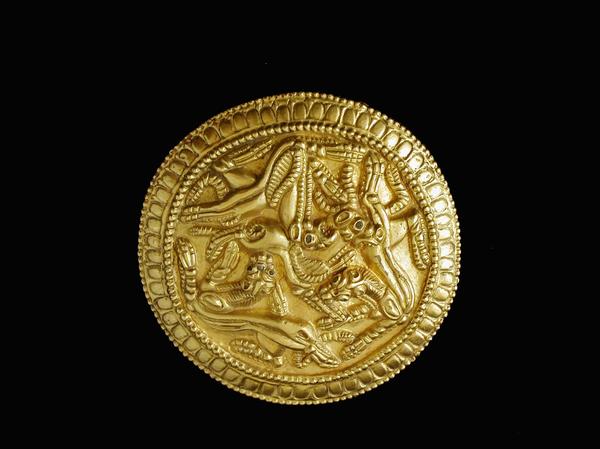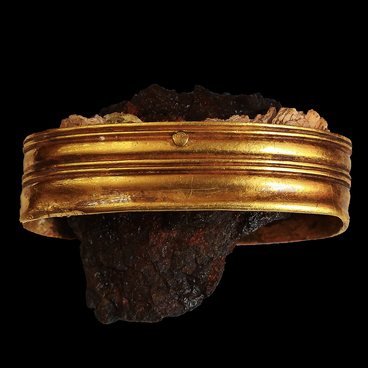Phalerae are items for decorating horse harnesses and distributing harness belts. This exhibit from our collection was created within the period from the 1st century BC to the 1st century AD. Most likely, it was crafted at the ancient sites of the East.
The round phalera is made on a bronze base with gold plating. Eyes made of forged bronze plate were attached to the base. The phalera is decorated with a repoussé zoomorphic ornament depicting a scene of a torment. It involves two panthers, a griffin (a fantastic animal with the body of a lion and the head of an eagle) and a fantastic animal with wings and horns depicted in the middle of the composition. Scientists have not yet come to a common conclusion what kind of animal it is. Valentin Shilov whose archaeological team found the phalera believed that it was a fantastic goat. Other scientists thought that it could be a lion griffin or a winged wolf. The so-called nosed wolf is one of the famous characters in the zoomorphic repertoire of the animal style of the Scythian era. Its images with horns and wings are not rare occurrences. Most likely, the Sarmatian animal style was enriched with the wolf-dragon image where the wolf united with the body of the Chinese hydra under the influence of the Chinese art of the Central Asia.
One of the phalera features is the decoration with a small number of inserts: an ancient craftsmab used coloured stones only to emphasize the eyes and ears of animals, and sometimes the nose (of the central figure) or the bridge of the nose (of the panther). As a rule, such inserts in the Scythian-Sarmatian style were used to decorate items quite abundantly by combining larger and smaller stones. For example, the large ones emphasized the strong muscles of animals, while the small ones were used for teeth, claws, ears, and bird feathers.
The phalera was found in 1964 on a mound near ZhUtovo station by the Astrakhan archaeological expedition arranged by Leningrad branch of the Institute of Archeology of the USSR Academy of Sciences and led by ValentIn ShIlov.
In 2005, the item and other valuable finds were exhibited at the Astrakhan Steppe Treasures show at the National Museum of the Palazzo Venezia in Rome. In 2008, it was presented at the Gold of the Sarmatians show at the State Historical Museum in Moscow.
The round phalera is made on a bronze base with gold plating. Eyes made of forged bronze plate were attached to the base. The phalera is decorated with a repoussé zoomorphic ornament depicting a scene of a torment. It involves two panthers, a griffin (a fantastic animal with the body of a lion and the head of an eagle) and a fantastic animal with wings and horns depicted in the middle of the composition. Scientists have not yet come to a common conclusion what kind of animal it is. Valentin Shilov whose archaeological team found the phalera believed that it was a fantastic goat. Other scientists thought that it could be a lion griffin or a winged wolf. The so-called nosed wolf is one of the famous characters in the zoomorphic repertoire of the animal style of the Scythian era. Its images with horns and wings are not rare occurrences. Most likely, the Sarmatian animal style was enriched with the wolf-dragon image where the wolf united with the body of the Chinese hydra under the influence of the Chinese art of the Central Asia.
One of the phalera features is the decoration with a small number of inserts: an ancient craftsmab used coloured stones only to emphasize the eyes and ears of animals, and sometimes the nose (of the central figure) or the bridge of the nose (of the panther). As a rule, such inserts in the Scythian-Sarmatian style were used to decorate items quite abundantly by combining larger and smaller stones. For example, the large ones emphasized the strong muscles of animals, while the small ones were used for teeth, claws, ears, and bird feathers.
The phalera was found in 1964 on a mound near ZhUtovo station by the Astrakhan archaeological expedition arranged by Leningrad branch of the Institute of Archeology of the USSR Academy of Sciences and led by ValentIn ShIlov.
In 2005, the item and other valuable finds were exhibited at the Astrakhan Steppe Treasures show at the National Museum of the Palazzo Venezia in Rome. In 2008, it was presented at the Gold of the Sarmatians show at the State Historical Museum in Moscow.



